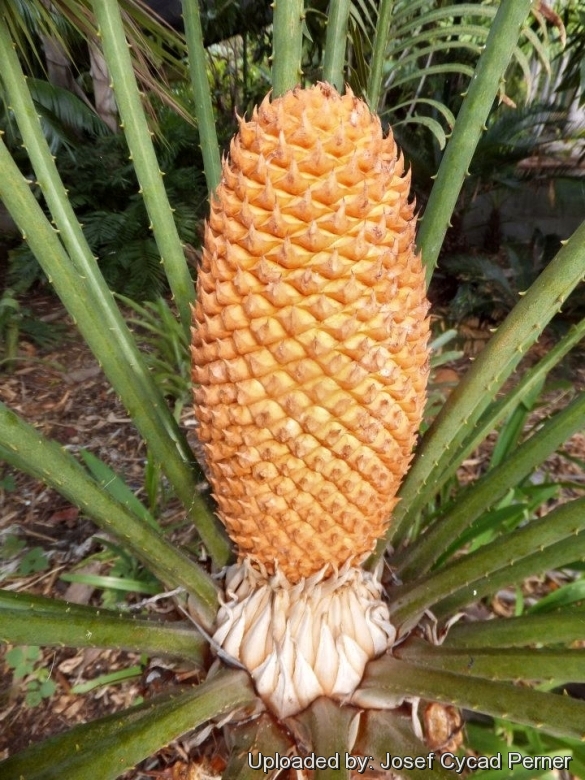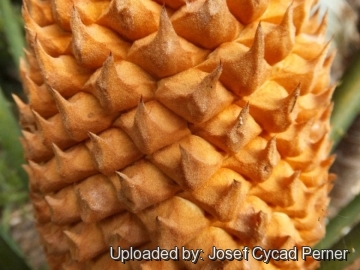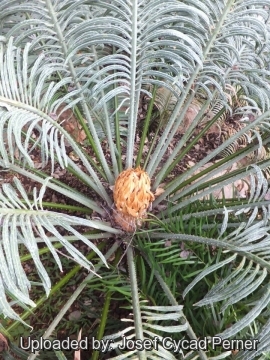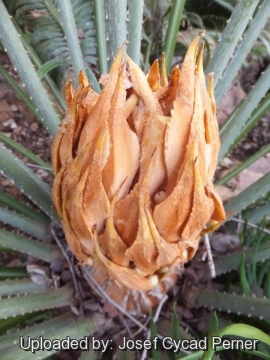




Your support is critical to our success.

Origin and Habitat: Cycas thouarsii is a widespread species abundant particularly in east coast of Madagascar, the Comoros Islands, Mayotte and the Seychelles (Aldabra). Scattered occurrences are also known on the East Coast of Africa from Tanzania (Pemba), throughout Kenya south the Mozambique, where the species may have been established by Arab traders because of its beauty and food value, but some of the stands appear to be long-established and likely to pre-date seafaring traders. It is locally abundant species with the population estimated to number more than 10,000 mature individuals. The closest related species is Cycas circinalisSN|28817]]SN|28817]] distributed from southern India to the Philippines, and it indicates a former phytogeographic connection between Madagascar and Asia.
Altitude range: Sea level up to 200 metres.
Habitat and ecology: Like others in this group, Cycas thouarsii is a species of near-coastal sites, where it grows in open coastal forests behind beaches and on headlands, often on calcareous sand derived from corals. They occur sparsely as individuals or in small groups. Rainfall ranges between 1,000 to 3,000 mm per annum. Although there are some threats, although plants would have been impacted in places by collectors, coastal developments (tourist resorts, urban expansion) and agricultural expansion (small-holder crops), these are not significant enough to warrant listing the species in a threatened category. Generation Length about 40
Synonyms:
- Cycas thouarsii R.Br.
- Cycas circinalis subs. thouarsii (R.Br.) Engl.
Cycas thouarsii R.Br.
Prodr. Fl. Nov. Holland. 347 (1810)
Synonymy: 9
- Cycas thouarsii R.Br.
- Cycas circinalis subs. thouarsii (R.Br.) Engl.
- Cycas circinalis f. trigonocarpoides J.Schust.
- Cycas comorensis Bruant
- Cycas kirkii J.Schust.
- Cycas madagascariensis Miq.
- Cycas circinalis subs. madagascariensis (Miq.) J.Schust.
- Cycas thouarsii R.Br. ex DC.
- Cycas wendlandii Sander
ENGLISH: Madagascar Cycad, African Cycas
CZECH (Čeština): Cykas Thouarsův
Description: Cycas circinalisSN|28817]], sometimes misspelt "thuarsii", is a palm-like cycad that grows to become one of the largest species and probably the fastest-growing. It is the only member of the cycad family in Madagascar and can reach over 10 metres tall, with a thick trunk up to 45 cm diameter, producing offsets along its length. It generates up to 40 leaves at a time, each up to 3 metres long and is very similar in appearance to Cycas rumphiiSN|31824]]SN|31824]]. Cycas thouarsii may be the oldest living Cycad, surviving unchanged from the Mesozoic (100-190 million years ago), became the most significant single plant adaptation in the history of life. The flowers are dioecious (individual flowers are either male or female, but only one sex is to be found on any one plant so both male and female plants must be grown if seed is required). The male flowers are united in a cone, and the female plant produces globose naked seeds. The plant is not self-fertile.
Distinguishing features: Distinguished within the group of species with spongy endocarp by the distinctly bluish new leaves with wholly spinescent petioles and the pronounced stout spines on the microsporophylls. Seeds do not have a crested sclerotests.
Derivation of specific name: The epithet “thouarsii” honours the French botanist Louis-Marie Aubert du Petit-Thouars (1758-1831).
Stem (trunk): Monopodial, well-developed, cylindric, casually branched when old, 3.5-10 metres tall, covered with the
Leaves: 1.5-2.1(-3) metres long, 30-60 cm wide above the middle, flat (not keeled) in section (opposing leaflets inserted at 170-180° on rachis), bright green, shining above, rather paler beneath, tomentum shedding as leaf expands. Petiole 40-50 cm long, spinescent and slightly angular, quite glabrous. Rachis usually terminated by paired leaflets. Median leflets very coriaceous, 60–100 pairs, simple, linear, gently curved, (20-)22-32(-38) cm long, 8-12 mm wide, , inserted at 45° to rachis, slightly unequally attenuated at the base the lower edge there shortly decurrent and somewhat concave, apex acutely acuminate slightly indurated, but not spinescent, margin entire and slightly recurved on either edge, midrib prominent grooved above, raised below.. Basal leaflets not gradually reducing to spines, 170 mm long.
Cataphylls: The cataphylls (Modified leaf, much reduced and thickened, serving to protect the apical meristem in cycads produced in flushes preceding the emergence of cones or leaves.) are narrowly triangular, pungent, pilose and persistent.
Male cone: Shortly peduncled, brown, oblong-cylindric to fusiform, orange to brown (pale), 30-45 cm long, 12-15 cm wide; peduncle under 5 cm long, sparingly brown-pubescent; scales horizontally spreading, obovate-deltoid, 4-5 cm long, 12-18 mm wide, microsporophyll lamina firm, not dorsiventrally thickened, with a barren glabrous basal portion 5 mm long, fertile portion glabrous, 2.5-3 cm long, considerably longer than broad, apical spine prominent, sharply upturned, 18 mm long, clothed externally with close brown tomentum, glabrous above.
Female spike: When female inflorescences are present, the genus Cycas can easily be recognized by the loose structure of the inflorescence, as in all the other genera the female inflorescences are compact cones. Instead Cycas rumphii carry ovules and seeds on fleshy, leaf-like megasporophylls about 9-32 cm long, yellow-tomentose. Stalk long, rusty-pubescent, with 2-6 glabrous ovules above the middle, passing insensibly into the ovate-lanceolate lamina, which is ovate to lanceolate, 80-100 mm long, 20-25(-30) mm wide, obscurely dentate or subentire, with 12-16 soft lateral spines 0-2 mm long, apical spine distinct from lateral spines, 15-35 mm long. glabrous on both sides towards apex and margins, elsewhere closely rusty- on both sides towards apex and margins, elsewhere closely rusty-pubescent.
Seeds:ovoid-globose, 50-60 mm long, 4 cm wide; outer coat ( sarcotesta) red to orange-brown, fibrous layer absent; sclerotesta smooth. Spongy endocarp present.
Note: Cycas thouarsii is most nearly allied to Cycas rumphiiSN|31824]]SN|31824]], Miq., from south-eastern Asia, and rather less closely to Cycas circinalisSN|28817]], Linn., from southern India and south-eastern Asia, of which it has been considered by some authors to be a geographical form.
Subspecies, varieties, forms and cultivars of plants belonging to the Cycas rumphii complex
The C. rumphii complex comprises a number of related taxa which have sometimes been considered conspecific. Differences between these taxa lie mainly in the shape and indentation of the lamina of the megasporophylls.
 Cycas circinalis L.: has leaflets not more than 13 mm broad, non-pepectinate megasporophyll with large lamina. Microsporophyll apex attenuate, reflexed. Distribution: southern India.
Cycas circinalis L.: has leaflets not more than 13 mm broad, non-pepectinate megasporophyll with large lamina. Microsporophyll apex attenuate, reflexed. Distribution: southern India. - Cycas glauca Miq.
- Cycas micronesica K.D.Hill
 Cycas rumphii Miq.: has broad, falcate, hard, glossy leaflets with relatively broad bases, usually wholly spinescent petiole, and narrowly triangular megasporophyll lamina with a slender apical spine. Distribution: Indonesia, S. Borneo ans along the north coast of Papua New Guinea.
Cycas rumphii Miq.: has broad, falcate, hard, glossy leaflets with relatively broad bases, usually wholly spinescent petiole, and narrowly triangular megasporophyll lamina with a slender apical spine. Distribution: Indonesia, S. Borneo ans along the north coast of Papua New Guinea. Cycas thouarsii R.Br.: has distinctly bluish new leaves with wholly spinescent petioles and the pronounced stout spines on the microsporophylls. Seeds do not have a crested sclerotests. Distribution: Madagascar, the Comoros Islands, Mayotte and the Seychelles. Scattered occurrences are also known on the East Coast of Africa from Tanzania throughout Kenya south the Mozambique.
Cycas thouarsii R.Br.: has distinctly bluish new leaves with wholly spinescent petioles and the pronounced stout spines on the microsporophylls. Seeds do not have a crested sclerotests. Distribution: Madagascar, the Comoros Islands, Mayotte and the Seychelles. Scattered occurrences are also known on the East Coast of Africa from Tanzania throughout Kenya south the Mozambique.- Cycas zeylanica (J.Schust.) A.Lindstr. & K.D.Hill
Bibliography: Major references and further lectures
1) Golding, J. & Hurter, J. 2010. “Cycas thouarsii”. The IUCN Red List of Threatened Species 2010: e.T41940A10606292. http://dx.doi.org/10.2305/IUCN.UK.2010-3.RLTS.T41940A10606292.en . Downloaded on 04 October 2015.
2) Werner Rauh “Succulent and xerophytic plants of Madagascar”, Volume 1 Strawberry Press, 1995
3) D. Prain, “Flora of Tropical Africa”, Vol 6, Part 2, page 344, 1917.
4) Terrence Walters, Roy Osborne “Cycad Classification: Concepts and Recommendations” CABI, 12/gen/2004
5) Haynes J.L, “World List of Cycads: A Historical Review” IUCN/SSC Cycad Specialist Group, 2012
6) Jones, D.L. “Cycads of the World.” 2nd edn. Reed, Sydney. 2002.
7) Whitelock, L.M. “The Cycads.” Timber Press, Portland, Oregon. 2002
8) PACSOA contributors "Cycas thouarsii". In: Cycads. Palm and Cycad Societies of Australia (PACSOA). 24 November 2013 Web. 02 October 2015.
9) “Cycas thouarsii” Cycads.com, Jurassic Garden, A&A Cycads and Maurice Levin 2001-2013 <http://www.cycadpalm.com/cycthouarbea.html#sthash.WDKClVwR.dpuf> Web. 18 Nov. 2014
10) Umberto Quattrocchi “CRC World Dictionary of Medicinal and Poisonous Plants: Common Names, Scientific Names, Eponyms, Synonyms, and Etymology” (5 Volume Set) CRC Press, 03 May 2012
11) Boris Lariushin “Cycadaceae Family” Lulu.com
12) Cheryll Williams “Medicinal Plants in Australia Volume 3: Plants, Potions and Poisons” Rosenberg Publishing, 01 July 2012
13) Hilary Bradt, Daniel Austin “Madagascar” Bradt Travel Guides, 01 July 2014
14) Wikipedia contributors. "Cycas thouarsii." Wikipedia, The Free Encyclopedia. Wikipedia, The Free Encyclopedia, 10 Sep. 2015. Web. 4 Oct. 2015.
15) Oliver Sacks “The Island of the Colour-blind: And, Cycad Island. Picador.” p. 221, October 1997.
16) The Cycad Pages “Cycas thouarsii” Royal Botanic Gardens Sydney Written and maintained by Ken Hill 1998-2010 Maintained by Leonie Stanberg and Dennis Stevenson 2010-2012 <http://plantnet.rbgsyd.nsw.gov.au/cgi-bin/cycadpg?taxname=Cycas+thouarsii> Web. 25 August 2015
17) Else Marie Friis, Peter R. Crane, Kaj Raunsgaard Pedersen “Early Flowers and Angiosperm Evolution” Cambridge University Press, 18 August 2011

Cycas thouarsii, male cone. Photo by: Josef Cycad Perner

Cycas thouarsii seeds Photo by: Josef Cycad Perner

Cycas thouarsii, Receptive Female. Photo by: Josef Cycad Perner

Cycas thouarsii, Receptive Female. Photo by: Josef Cycad Perner
Cultivation and Propagation: Cycas thouarsii is suited to tropical regions which have a seasonally dry climate, but it grows best in a moist, well-drained location, with light shade. During dry periods, it benefits from mulches and ample watering, and can handle occasional temperatures down to -2°C. It is often the focal point in a large yard.
Growth rate: Usually slow growing, however good conditions can speed it up considerably. Because of its growth habit, fertilize only when terminal bud begins to swell, indicating the start of the annual growth cycle.
Exposure: It prefers bright light exposure but colour bleaches when in full sun; best with some protection from afternoon heat.
Soil: Needs a well drained spot, with deep soil, but will still thrive in less than ideal conditions.
Maintenance: Minimal; removal of offsets if desired, removal of spent fronds.
Use: Landscape as cultivated perennial in warm, coastal areas; House-plant or interior-scape, as container plant in cool areas, as well very well suited to bonsai culture.
Use as food: This species is said to be a source of Sago in Madagascar and perhaps Mauritius. The starch in seed and in the pith of the trunk is poisonous. The potent poison in the seeds is removed by soaking them in water. Water from the first seed-soaking will kill birds, goats, sheep and hogs. Water from the following soakings is said to be harmless. After the final soaking, the seeds are dried and ground into flour. The flour is used to make tortillas, tamales, soup and porridge. However, consumption of the flour may result in a neurological disorder because of the neurotoxins content; there is so far no evidence of its economic use on the African continent.
Propagation: Seed. As a slow growing plant, the seed can take from 6–18 months to germinate. After fertile seeds are collected, they usually need several months of storage before the inner embryo is ready to germinate. Therefore, it is best to clean the seeds of external fruit and set them aside before attempting to propagate the seeds.
| Your Actions | |
|---|---|
| Back to Cycas index | |
| Back to Cycadaceae index | |
 |
Back to Palms And Cycads Encyclopedia index |
Privacy stantement - Terms and conditions - How to cite - About us - Feedback - Donate


